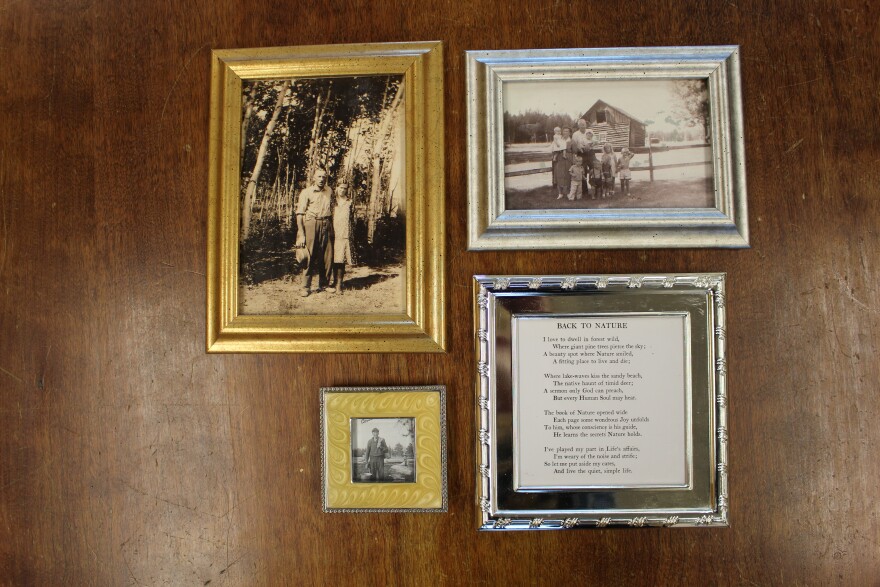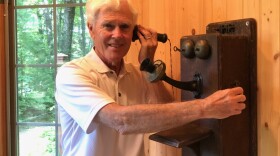As part of our We Live Up Here series, we're telling stories about the people and culture of northern Wisconsin.
Today, Northwoods resident Kathryn Luttkus Craffey has a story about the relationship between her grandfather and the Northwoods Poet Enos Hayward, also known as the "Poet of the Pines."
I wondered how it was that my grandfather — a burly, Lithuanian farmer-logger named Herman Luttkus — who moved to the Wisconsin north woods in the early part of the last century — began to write poetry. I might now have my answer. It could be due to his connection with Enos Hayward.
Iowa-born Enos Franklin Hayward known as the Poet of the Pines lived beside Haymeadow Creek, a creek winding along old Highway 45, the former Highway 32, two miles north of the Town of Conover, in Vilas County.
Hayward lived off the grid but in close range to the Rummels Road flag stop. Flag stops were the pauses trains made upon rider request. From his modest wood cabin, chunked with plaster, Hayward put into verse his observations and his values. It was prosing he did between hunting, farming, and clearing 80 acres, without use of dynamite or stump pullers.

The pace of Hayward’s life became more deliberate in contrast to his former years — time spent selling real estate and roaming the country hawking garment-cutting machines. Perhaps it was the elimination of that bustle and noise that allowed creative thought.
The first of Hayward’s books, published in 1904, was “Two Bits.” It was followed by “Monologues,” “Hayward’s Philosophy,” “Philosophy of Rhymes,” “Poems from the North Woods,” “Souvenir,” “Barber Shop Chatter,” “Moccasin Trails,” and “Kiddie Jingles.”
North Woods was released in 1922. It’s a 176-page poetry journal that describes land clearing, highway construction and home building in a manner his publisher said, “Appeals strongly to men who have struggled and either won or lost.” Hayward’s philosophy was one of optimism and offering, “A smile no matter how the wind blows.”
The Boston Globe in 1922 thought “North Woods” a worthy read. Their reviewer opined, “Those who are looking for new sensations will like the poems — the author has true poetic insight on many topics.”
A gentler way of life is something Hayward seemed to embrace:
“I’ve been out in the world with its noise and confusion; where selfishness reigns in the getting of gold; where to advocate honor is deemed an intrusion; where virtue and manhood are openly sold; I’ve been longing to hear the word welcome again; it makes this old world seem a whole lot more cheery; seems just like the sunshine after the rain.”
Those who experienced our recent prolonged winter will appreciate “Paradox But True” from Hayward’s “Northwoods” that states:
“I love the winter’s chilly blast, the snow and sleety storm
But love them most when they have passed
And it is nice and warm”
Despite his authorship, Hayward lists his profession as laborer and farmer in both the 1910 and 1920 census. It wasn’t until 1930 that he felt bold enough to call himself an author and writer.
As for Hayward’s connection to my grandfather, I discovered through records that my grandfather had lived with the poet and his wife, Eva, during the time Hayward wrote “Northwoods.” Hayward then was with my grandfather when he bought lumber and hardware so that he, too, could forge his own pioneer life.

Today, the bugle calls from Sandhill Cranes continue high above Haymeadow Creek, at the former Haymeadow Farm, just as Hayward described in 1922 — ”the wild birds fill the air with song.” But the ordinary-looking cabin Hayward carved out of wilderness, near the Rummels train stop, is just an empty shell, the building’s walls tilt in haphazard angles where a clearing meets a woodland. Perfect dowel joints are spread wide apart and no longer functional.
I believe it was in that rustic cabin that my immigrant, barely English-speaking grandfather, between violin riffs and attempts to get checkers kinged, acquired an interest in poetry. And, to think he was taught under the wing of one of our area’s most prolific poets, Enos Hayward. To me, a person who loves to write and tell stories, this discovery is anything but ordinary.
Northwoods resident Kathryn Craffey loves her husband, her dogs, and days that are nice and warm.
This story was written by Kathryn Craffey and produced for radio by Mackenzie Martin. It's part of our We Live Up Here series, where we tell the stories of the people and culture of northern Wisconsin. Some music for this story came from Podington Bear.
This story was funded in part by a grant from the Wisconsin Humanities Council, with funds from the National Endowment for the Humanities and the State of Wisconsin. Any views, findings, conclusions or recommendations expressed in this project do not necessarily represent those of the National Endowment for the Humanities. The Wisconsin Humanities Council supports and creates programs that use history, culture, and discussion to strengthen community life for everyone in Wisconsin.





